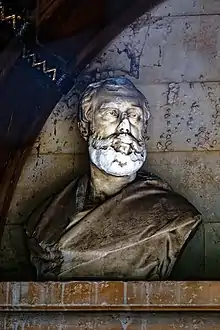William Haywood (engineer)
William J. Haywood (8 December 1821 – 13 April 1894) was an English surveyor and an engineer to the City of London Commissioners of Sewers. He was also known as an architect.

Personal life
William Haywood was born as the eldest of three children in Camberwell. His father was probably also called William Haywood. Nothing is known about his mother. In the census of 1871 he was no longer alone and living in Maida Vale.
He died at 56 Hamilton Terrace, Maida Vale, on 13 April 1894.[1]
Education
He was probably educated in Camberwell. There are records suggesting he went to Camberwell Grammar School. Later he trained with George Aitchison (1792–1861).
Work
_(14778174872).jpg.webp)
With Joseph Bazalgette he was responsible for the enormous undertaking of improving the London sewerage system, which enabled the growth of the city (Abbey Mills pumping station). He worked with James Bunning on the Holborn Viaduct.[1]
His main work is the City of London Cemetery and Crematorium. The facility was built near Little Ilford (now Manor Park) as a way of relieving the appalling overcrowding of London's church burial grounds (described e.g. in Dickens's 'Bleak House'). As the City was redeveloped the remains from many of its churchyards were reinterred there. Haywood was a pioneer of cemetery reform.
He was a Lieutenant-Colonel of the London Volunteer Rifle Brigade.[2]
There is a small Gothic mausoleum, containing his ashes, near the gates of The City of London Cemetery and Crematorium.
Other activities
In 1858, Haywood was one of the founders of the Geologists' Association.[3][4]
In an article published in 2002, John Patrick Pattinson suggested that Haywood was the pseudonymous "Walter", the author of the erotic memoir, My Secret Life.[5]
References
- Beare, Thomas Hudson (1901). . In Lee, Sidney (ed.). Dictionary of National Biography (1st supplement). London: Smith, Elder & Co.
- "Exterior plaque to William Haywood on the 1889-constructed buttressed, crocketed and pinnacled tomb holding the ashes of Lieutenant Colonel William Haywood (1821-1894), the tomb also including the ashes of his wife Jemima Emma (1841-1896), at the City of London Cemetery, Newham, London, England. The City of London Cemetery was laid out to the designs of William Haywood, who also aided Joseph Bazalgette in the design and improvement of the London sewerage system, and worked with James Bunning on the Holborn Viaduct.Mobile device view: Wikimedia (April 2020) makes it difficult to immediately view photo groups related to this image. To see its most relevant allied photos, click on City of London Cemetery and Crematorium, and this uploader's Photos. You can add a click-through 'categories' button to the very bottom of photo-pages you view by going to settings... Three-bar icon top left.Desktop view: Wikimedia (April 2020) makes it difficult to immediately view the helpful category links where you can find images related to this one in a variety of ways; for these go to the very bottom of the page.This image is one of a series of date and/Or subject allied consecutive photographs kept in progression or location by file name number and/Or time marking.Camera: Canon EOS 6D Mark II with Canon EF 24-105mm F4L IS USM lens.Software: File lens-corrected, optimized, perhaps cropped, with DxO OpticsPro Elite, and likely further optimized with Adobe Photoshop CS2". 3 May 2020.
- "A true amateur". Geoscientist Online. July 2008. Retrieved 6 April 2016.
- Freeman, Eric F., (1994) "In search of W.J. Haywood"; Proceedings of the Geologists' Association Volume 105; pp. 161–166;
- John Patrick Pattinson, The man who was Walter, in Victorian Literature and Culture, Cambridge University Press, 2002, pp. 19–40
Further reading
- The government of Victorian London, 1855–1889: the Metropolitan Board of Works, The Vestries and The City Corporation; Owen, David Edward and Roy M. MacLeod; reprinted in 1982 by the Harvard University Press. 480pp. ISBN 0-674-35885-6
- Public sculpture of the City of London; Ward-Jackson, Philip; Liverpool University Press; 2003; 680pp; ISBN 978-0-85323-977-2.